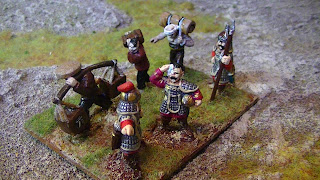About 15 years ago (I think) had passed on Arte a Chinese film whose title translated was The Silk Road. This film impressed me and was at the origin of several of my armies 15mm or 25mm.
(Moreover, it can not be found in France, if someone has a copy of it, I am a taker)
(Moreover, it can not be found in France, if someone has a copy of it, I am a taker)
Originally the Silk Road checkpoint, the town of Dunhuang is located to the east of the Taklamakan Desert, near the junction of the two caravan trails that bypassed the desert, one from the north, The other from the south, from Central Asia.
It is one of the main places of diffusion of Buddhism towards China.
During the second half of the seventh century, the Tibetans seized Dunhuang, and were driven out only by the Chinese Tang Dynasty in the year 851 by a Chinese general, Zhang Yichao, before the city fell The dependence of other populations.
27 km south-east of the city are the caves of Mogao, where magnificent mural paintings, numerous statues including a 35-meter high Buddha statue and valuable medieval manuscripts have been discovered. The rediscovery of the frescoes around 1946 is mentioned and described by François Cheng in his book Le Dit de Tianyi.
Dunhuang was built by the Chinese in prefecture in 11 BCE by the Hans near the Shazhou oasis (沙洲) on a decision of Emperor Han Wudi, and after the campaign against the Huns by General Huo Qubing. The city was an important point of trade between China and the outside world during the Han and Tang dynasties, to the point that in the 2nd century it had a considerable population of 76,000 inhabitants. The first Buddhist caves were dug in 353, decorated with paintings by the pious travelers to guarantee the good completion of the perilous journey they had undertaken.
During the second half of the seventh century, the Tibetans seized Dunhuang, and were only expelled by the Chinese general, Zhang Yichao, by the end of the Tang Dynasty in 851 before the city fell Dependent on other populations.
That is why I chose, for my army, figurines of Tibetan heavy horsemen, not caparisoned, and Chinese-style infantry.
As early as the 16th century, the region escaped the Chinese empire, falling under the khaki of Djakhata
.During the second half of the seventh century, the Tibetans seized Dunhuang, and were only expelled by the Chinese general, Zhang Yichao, by the end of the Tang Dynasty in 851 before the city fell Dependent on other populations.
That is why I chose, for my army, figurines of Tibetan heavy horsemen, not caparisoned, and Chinese-style infantry.
As early as the 16th century, the region escaped the Chinese empire, falling under the khaki of Djakhata
 |
| Heavy cavalry I |
 |
| Heavy cavalry II |
 |
| Turkish mercenaries |
 |
| Levies |
 |
| Milices I |
 |
| Milices II |
 |
| Baggages |
 |
| The whole army with the allied body Tü Chüeh |








